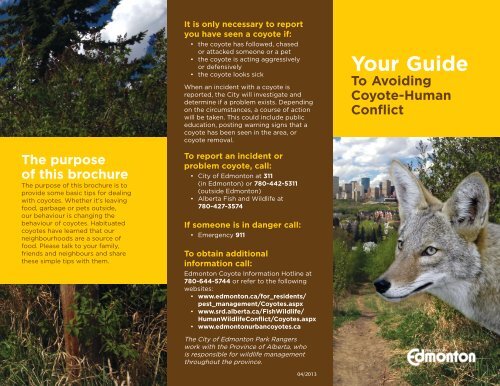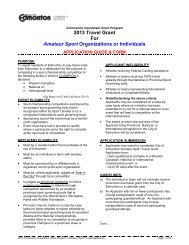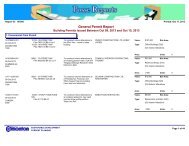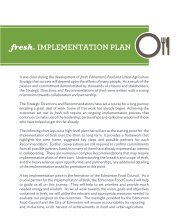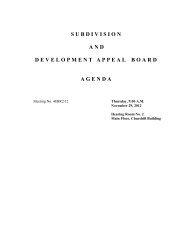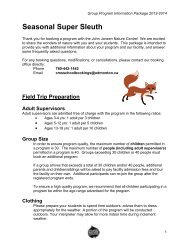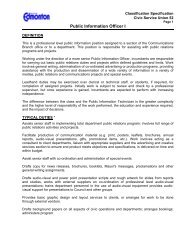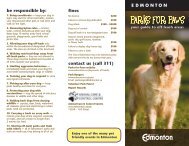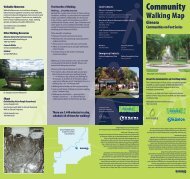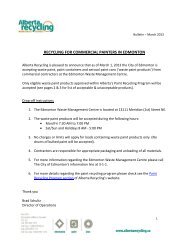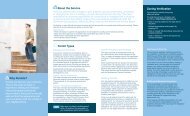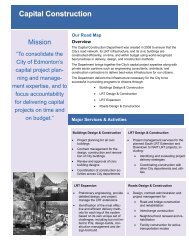Avoiding Coyote-Human Conflict Brochure - City of Edmonton
Avoiding Coyote-Human Conflict Brochure - City of Edmonton
Avoiding Coyote-Human Conflict Brochure - City of Edmonton
Create successful ePaper yourself
Turn your PDF publications into a flip-book with our unique Google optimized e-Paper software.
It is only necessary to report<br />
you have seen a coyote if:<br />
• the coyote has followed, chased<br />
or attacked someone or a pet<br />
• the coyote is acting aggressively<br />
or defensively<br />
• the coyote looks sick<br />
When an incident with a coyote is<br />
reported, the <strong>City</strong> will investigate and<br />
determine if a problem exists. Depending<br />
on the circumstances, a course <strong>of</strong> action<br />
will be taken. This could include public<br />
education, posting warning signs that a<br />
coyote has been seen in the area, or<br />
coyote removal.<br />
Your Guide<br />
To <strong>Avoiding</strong><br />
<strong>Coyote</strong>-<strong>Human</strong><br />
<strong>Conflict</strong><br />
The purpose<br />
<strong>of</strong> this brochure<br />
The purpose <strong>of</strong> this brochure is to<br />
provide some basic tips for dealing<br />
with coyotes. Whether it's leaving<br />
food, garbage or pets outside,<br />
our behaviour is changing the<br />
behaviour <strong>of</strong> coyotes. Habituated<br />
coyotes have learned that our<br />
neighbourhoods are a source <strong>of</strong><br />
food. Please talk to your family,<br />
friends and neighbours and share<br />
these simple tips with them.<br />
To report an incident or<br />
problem coyote, call:<br />
• <strong>City</strong> <strong>of</strong> <strong>Edmonton</strong> at 311<br />
(in <strong>Edmonton</strong>) or 780-442-5311<br />
(outside <strong>Edmonton</strong>)<br />
• Alberta Fish and Wildlife at<br />
780-427-3574<br />
If someone is in danger call:<br />
• Emergency 911<br />
To obtain additional<br />
information call:<br />
<strong>Edmonton</strong> <strong>Coyote</strong> Information Hotline at<br />
780-644-5744 or refer to the following<br />
websites:<br />
• www.edmonton.ca/for_residents/<br />
pest_management/<strong>Coyote</strong>s.aspx<br />
• www.srd.alberta.ca/FishWildlife/<br />
<strong>Human</strong>Wildlife<strong>Conflict</strong>/<strong>Coyote</strong>s.aspx<br />
• www.edmontonurbancoyotes.ca<br />
The <strong>City</strong> <strong>of</strong> <strong>Edmonton</strong> Park Rangers<br />
work with the Province <strong>of</strong> Alberta, who<br />
is responsible for wildlife management<br />
throughout the province.<br />
04/2013
About coyotes<br />
<strong>Coyote</strong>s play a natural and beneficial<br />
role in the food chain by eating mice<br />
and other small rodents. They are<br />
extremely adaptable animals that<br />
help maintain healthy ecosystems.<br />
<strong>Coyote</strong>s are part <strong>of</strong> the dog family but<br />
have very long legs, oversized pointed<br />
ears and large bushy tails with black<br />
tips. An average adult coyote weighs<br />
9 to 14 kilograms and is just over a<br />
metre long from nose tip to the tip <strong>of</strong><br />
their tail. <strong>Coyote</strong>s have light grey or tan<br />
coats and slim pointed muzzles.<br />
Why are coyotes<br />
living in the city?<br />
<strong>Coyote</strong>s have long existed within the<br />
boundaries <strong>of</strong> the city but most stayed<br />
in the river valley. As our city grows<br />
and expands into their habitat, more<br />
coyotes are adapting to food sources<br />
in residential areas, eating readily<br />
available food such as garbage,<br />
fruit and accessible pet food.<br />
Are coyotes dangerous?<br />
<strong>Coyote</strong>s have a natural fear <strong>of</strong> humans but<br />
may become defensive and may attack if<br />
they are protecting their food or a den.<br />
In cases <strong>of</strong> coyote attacks on people, it<br />
usually involves a coyote that has been fed<br />
by humans. Experts agree that coyotes will<br />
steer clear <strong>of</strong> humans until they learn that<br />
people are a source <strong>of</strong> food.<br />
<strong>Coyote</strong>s and pets<br />
<strong>Coyote</strong>s view dogs as competition. If a dog<br />
comes into their territory, they may attempt<br />
to intimidate the dog. Keeping dogs on a<br />
leash at all times is the best way to ensure<br />
the safety <strong>of</strong> the dog and the owner.<br />
<strong>City</strong> <strong>of</strong> <strong>Edmonton</strong>’s Animal Licensing<br />
and Control Bylaw prohibits owners from<br />
allowing their cats or dogs to roam free<br />
and unsupervised <strong>of</strong>f their property.<br />
By permitting your pets to roam free<br />
outside <strong>of</strong> your property, you provide<br />
the opportunity for a potentially serious<br />
encounter between your pet and a coyote.<br />
To help prevent conflicts<br />
with coyotes do not:<br />
• feed coyotes<br />
• leave garbage out<br />
• leave fallen fruit from trees, or bird<br />
seed spilled from feeders on the<br />
ground<br />
• leave pet food outside<br />
• walk your dog <strong>of</strong>f leash in areas<br />
fre quented by coyotes<br />
• leave a small dog out in the yard<br />
unattended for long periods <strong>of</strong> time<br />
• leave cats out roaming<br />
What to<br />
do if you<br />
encounter<br />
a coyote<br />
To prevent coyote attacks on humans,<br />
modern wildlife management focuses<br />
on ‘aversive conditioning’. This practice<br />
tries to change an animal’s behaviour by<br />
making every human-coyote encounter<br />
unpleasant for the animal. This method<br />
only works if we all respond to coyote<br />
encounters aggressively. If a coyote does<br />
approach, make it feel unwelcome. They<br />
should not feel comfortable around us.<br />
Take these immediate steps:<br />
• Respond to its presence aggressively<br />
by making yourself appear large<br />
(wave your arms overhead or shove<br />
long objects like a walking stick<br />
toward the coyote).<br />
• Throw rocks, sticks or other objects<br />
to scare it away.<br />
• Carry a whistle and blow it to startle<br />
the animal.<br />
• Carry dog spray in areas highly<br />
frequented by coyotes.<br />
• Shout in a deep voice and maintain<br />
eye contact.<br />
• Do not turn away or run. This may<br />
trigger a natural predator/prey<br />
instinct and might encourage the<br />
coyote to chase after you.<br />
• If the coyote continues to approach,<br />
back away slowly and move toward<br />
buildings or human activity.


